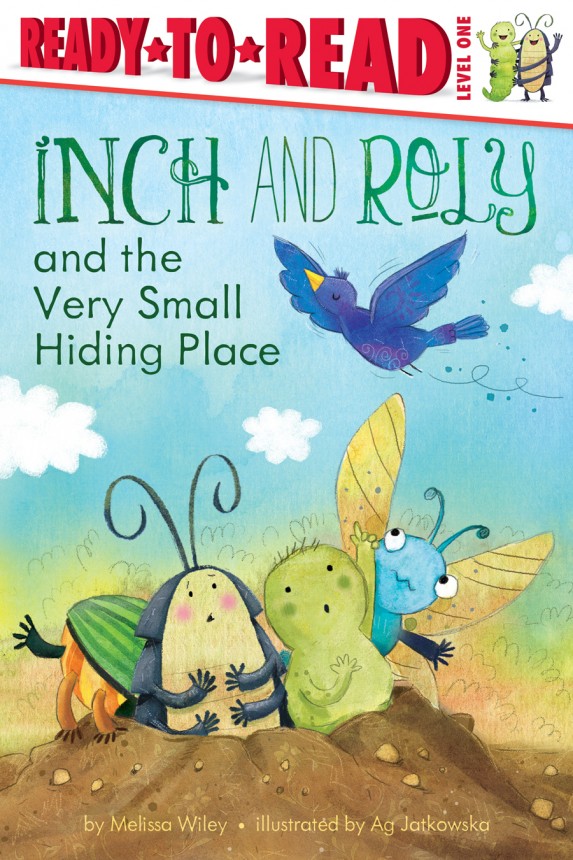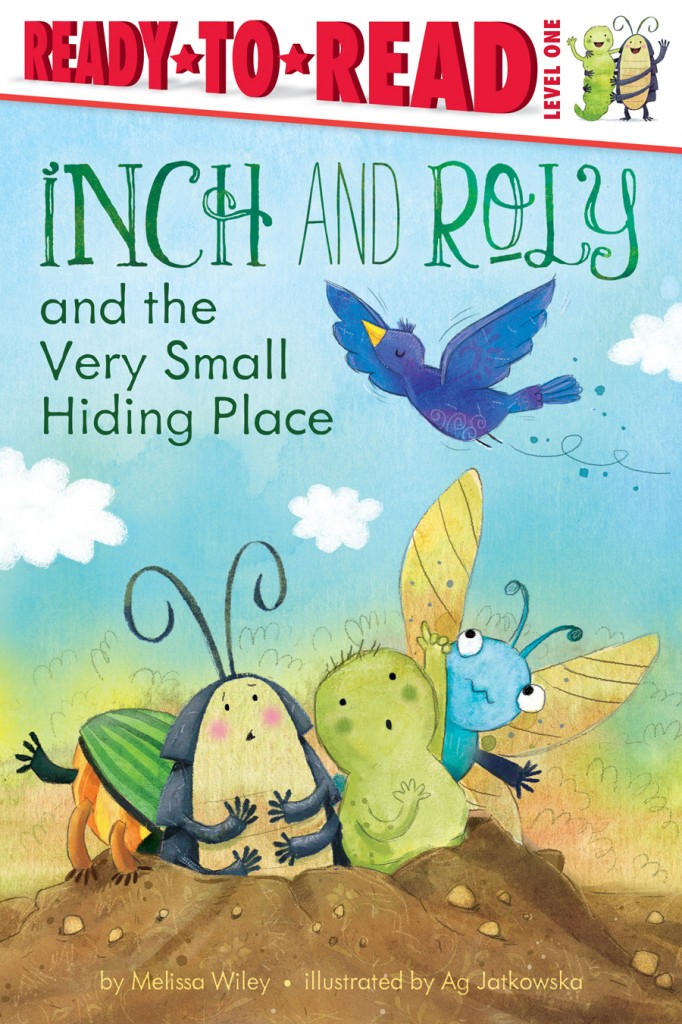September 19, 2021 @ 11:36 am | Filed under:
Books
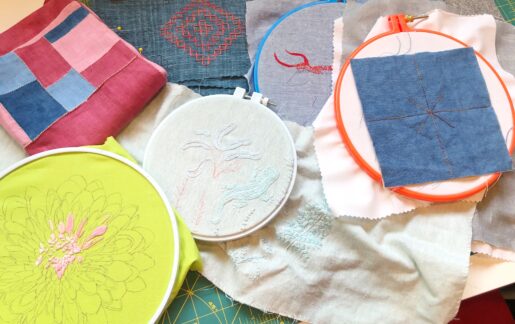
This is maybe half of my stitching projects currently-in-progress. Plus a pair of middle-grade novels, a picture book, a blog/essay collectionish thing, a nonfiction project, and Brave Writer Dart #5 of the 10 I’m writing this year. (Yep, that’s the whole year’s Dart lineup. The books are SO GOOD, y’all. A joy to write about.) This is why I’m not very good at promoting the books I’ve already published—the ones I really really hope people will keep buying because I love them and want them to stay in print—and I’m low-level worried all the time about neglecting them, but I would always, always rather be working on the next thing than promoting the finished ones.
And buried in this pile are two hoops from a project I am truly over-the-moon excited about, a set of original designs, and it would be awfully nice if someone could rustle up a way to fit about six extra hours into the day. I’m not greedy—five or six will do!
And the whole time I’m stitching, I’m thinking about the books, the middle-grades* mostly. Or, well, that isn’t quite accurate, because at night I listen to audiobooks while I stitch. But reading is a big part of writing, too. So in a way it’s all in service of the work.
*(I can’t decide which to focus on so I’m mapping out two at once, set in the same world. I told a friend on Friday that I’d like to have proposals ready to send to my agent by mid-October. Which is maybe a reasonable goal if I kick the clean-out-the-garage project down the road until, like, spring??)
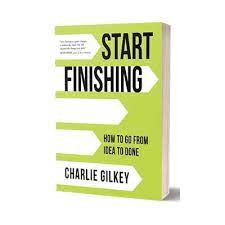 I love Charlie Gilkey’s book Start Finishing, and I’ve truly taken his advice to heart this past year, but BOY do I have a hard time with the crucial first step in his road map, which is recognizing that most of the time we can’t be actively moving forward on more than five projects at once.
I love Charlie Gilkey’s book Start Finishing, and I’ve truly taken his advice to heart this past year, but BOY do I have a hard time with the crucial first step in his road map, which is recognizing that most of the time we can’t be actively moving forward on more than five projects at once.
FIVE.
And that’s if all systems are go, no health issues, etc. (In this house, there are always health issues. I’ve had a miserable time with asthma this past month. Which is partly why I’ve managed to do so much stitching: too fatigued for all the household projects I’d envisioned barreling through this fall. Silver linings.)
Anyway, five projects. Words that send me into helpless laughter petering out with a rueful groan. When I try to narrow down All the Things, I cheat a lot.
1. Homeschooling (an ongoing project, decades deep now)
2. Client work. Lots of it. Counts as one big ongoing project with many, many subtasks.
3. Books in progress. A major cheat to count them as one project. At a certain point, I have to tuck a bunch of ideas away and focus on just one manuscript. But this is not that point.
4. A wild card spot. Any kind of household project bigger than basic daily chores. OR: the ongoing project of navigating Wonderboy’s medical appts and services. There are periods where this becomes intense, with several appointments in a short span of time, and that’s for sure when other things on this list have to be back-burnered. OR: a biggish reading project; research; study.
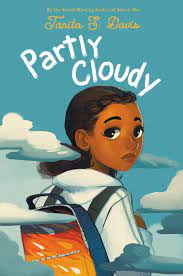 5. Book outreach — the one I’m forever neglecting — my newsletter and blog posts and reaching out to podcasters & teachers. I mean, this is really a whole job by itself! There are, like, professionals who make their entire living out of it! But the vast majority of published authors can’t afford that kind of help. We’ve got to champion our books ourselves. Which is…kind of excruciating? I would rather champion OTHER PEOPLE’S books. (Like Tanita Davis’s new one. You should buy it!)
5. Book outreach — the one I’m forever neglecting — my newsletter and blog posts and reaching out to podcasters & teachers. I mean, this is really a whole job by itself! There are, like, professionals who make their entire living out of it! But the vast majority of published authors can’t afford that kind of help. We’ve got to champion our books ourselves. Which is…kind of excruciating? I would rather champion OTHER PEOPLE’S books. (Like Tanita Davis’s new one. You should buy it!)
But what about…?
Stitching, you’ll notice, doesn’t land a spot on my Five Projects lists. Which may seem a bit bananas, since I’m obsessed with it and pretty much want to stitch all the time. But there’s a reason for it—a mini-revelation that gave me a lot of peace.
The thing about Projects is they require focus. Charlie Gilkey defines a project as activities that require time, energy, and attention. (TEA.) Most projects have some kind of Admin component, but to really move the work forward, the critical need is for Focus blocks. (What Cal Newport calls Deep Work.) Good-sized chunks of time—90 minutes to 2 hours is a good target, although for writing or, say, garage-cleaning, I prefer a 3-hour Focus block.
Most of us can only manage one, maaaaybe two Focus blocks in a given day. In Start Finishing, Gilkey notes that the rest of our time goes to routines, and admin, and social blocks (meetings, outings, phone calls), and…if we’re being good to ourselves, if we’re being wise: recovery blocks. Down time. Rest. Fun.
It was this Recovery part of Charlie’s road map that helped me make peace with the Five Projects (at most!) reality-check. Yes, I think of my stitching projects as projects. And they do take time and attention. But—here’s the glorious part—they don’t drain my energy. They restore it. They exhilarate me, thrill me—and they provide me with something I rarely experience otherwise.
Stillness.
I’m sitting still, stitching. My mind is still. I mean, it may be roaming, exploring the valley where my little book people live, or chewing on a post I mean to write—but it’s a contented, calm state. Not agitated. Not hyper. Not stressed or worried. Not holding mental arguments with That One Friend on Facebook. Not tacking items onto an endless to-do list. For me, stitching is a meditative activity; a vital part of my writing process; a means of rest and, yes, recovery.
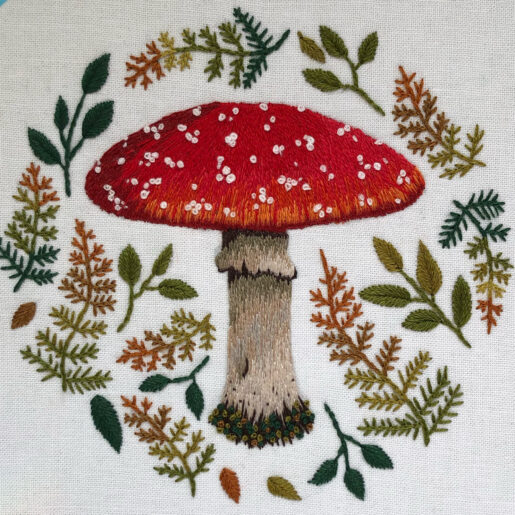
A few years back when I was feeling a bit desperate over a too-intense workload, my brilliant coach friend Helen McLaughlin suggested I make a list of activities that drain my energy, and activities that give me energy, to make sure my days had a reasonable balance of both.
Tops on the refueling list were: reading to my kids, singing with Low Bar Chorale, and making art. At the time, I was only just beginning to venture into embroidery. I was filling a lot of sketchbooks, trying to learn to draw and paint. Sketching stills my mind in much the same way stitching does. But the stitching high lasts longer: I like the way my embroidery projects come out more than I like my drawings. Gradually handstitching took precedence.
Interestingly, I find there’s an admin component to a stitching project, too. Cutting fabric, transferring a design (my own original one or a purchased pattern, depending), choosing colors, assembling supplies—this is the busywork part of the process that I usually save for weekends. That leaves me ready to sink into the bliss of a recovery state after a workday’s Focus session. If I time it right, my background mind can go on untangling whatever knotty problem may have popped up during the work, without me really noticing it. I think I’m puzzling out which stitches to use, and all of a sudden I discover I’ve written the next paragraph, the one I was sure I’d never get right.
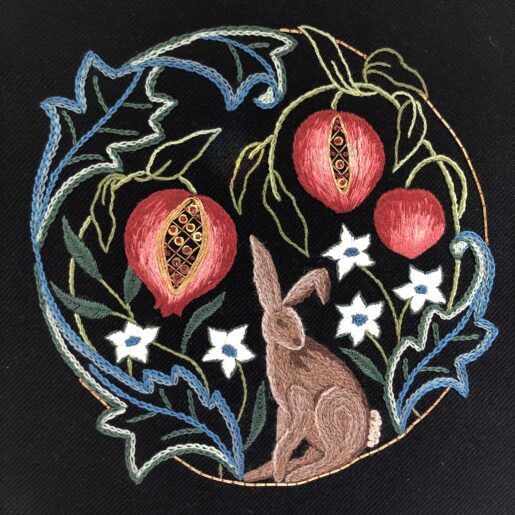
Writing this post (which believe it or not, started out as a simple Instagram Story caption—hahaha) has untangled its own kind of problem. The garage is going to have to wait. My much-avoided Project #5 needs some time in the spotlight. I’ve got to put my needle down and spend a little time joining the chorus of authors and booksellers who are encouraging readers to place holiday book orders as soon as possible. Worldwide shipping delays have the publishing world in a tizzy: everything (not just books) is taking a much longer time than usual to get from Point A to Point B, as I’m sure you’ve heard.
 Independent bookstores are begging customers to order holiday gifts early—like, NOW, no time to lose!—to ensure deliveries by December. Which means we authors need to make that plea, too. If you’d like to give one of my books (or Scott’s! They’re awesome) to the kids and teachers on your gift list, now is a perfect time. Same goes for any other books. Especially backlist titles that may already be in stock on the shelves at your favorite indie bookstore. Snap those up and everybody wins!
Independent bookstores are begging customers to order holiday gifts early—like, NOW, no time to lose!—to ensure deliveries by December. Which means we authors need to make that plea, too. If you’d like to give one of my books (or Scott’s! They’re awesome) to the kids and teachers on your gift list, now is a perfect time. Same goes for any other books. Especially backlist titles that may already be in stock on the shelves at your favorite indie bookstore. Snap those up and everybody wins!

Prairie Thief and Nerviest Girl are middle-grade novels, great for kids 8-12. Fox and Crow is a Level 3 beginning reader (also a fun readaloud for younger kids) and the Inch & Roly series is Level 1, for kids just beginning to read on their own (and good read-alouds for toddlers and preschoolers, because: roly polies! Inchworms! And of course all children’s books make excellent gifts for the teachers in your lives.
If you order online from Annie Bloom’s Books here in Portland, they’ll ring me up and I’ll zip over to sign your copies before they ship.









Tags: batman adventures, book orders, cal newport, charlie gilkey, comics, creative practice, deep work, early readers, embroidery, five projects rule, Fox and Crow Are Not Friends, global shipping delay, holiday shipping, Inch and Roly, nerviest girl, prairie thief, Scott Peterson, start finishing, stitching, Tanita Davis, writing
Bunch of books have to go back today; before they go, a quick catalog of the ones my gang loved:

 Gideon by Olivier Dunrea, from the Gossie & Friends series.
Gideon by Olivier Dunrea, from the Gossie & Friends series.
Huck enjoyed this short, simple story about a gosling who isn’t quite ready to take his nap. A repeat request, usually as a stall tactic at naptime. 😉 Sweet art; pleasingly small trim size. A good library choice, since Huck, at a month shy of four (eek), is on the top end of the age range this book is likely to appeal to.
A leveled reader that enchanted all three of my youngest. The homey adventures of imaginative twin girls with very different personalities. The making-dumplings chapter is Rilla’s favorite. She’s hoping for more Ling and Ting tales.
This early reader scored especially high with my boys. Huck’s an easy mark: you had him at “Robot.” Wonderboy was amused by the way Robot upended Rabbit’s careful sleepover plans. Plus: Magnetic hands! A lost remote control! A snack of nuts and bolts! And poor, flustered Rabbit, worrying about sticking to his schedule—a character Wonderboy can very much relate to. I might snag a copy of this one to keep.
One of the few Elephant & Piggie books we don’t own, which means we wind up checking it out often.
I’m sneaking Autumn Leaves out of the house after approximately thirty-seven reads.
Harmony asked:
I have a question which you may have written about somewhere… but anyway, I have a just-turning-3 boy. We’ve enjoyed a lot of the picture books you’ve recommended, but I think he may be getting ready for some longer books. I’m curious what chapter books have gotten your kids interested at early ages? Not to replace beautiful picture books of course! Just in addition. I’m thinking to try Winnie the Pooh… other ideas?
I guess I have two questions, because another thing I’ve wondered about is early readers. I think my son would love Frog and Toad, and Elephant and Piggie–but should I save those for when he can actually start to read them himself? Have you ever struggled with this?
These are great questions. I’ll start with the second batch first: nope, I’ve never saved beginning readers for actually-beginning-to-read children because—well, at first it was probably because I couldn’t wait to share those stories, but also it’s because beginning readers make such wonderful read-alouds for toddlers. It’s funny, though, now that you’ve made me consider the question, Harmony: I don’t think I’ve ever seen much discussion on this topic. But here’s what I think—wait, to get there, first I have to back up to picture books.
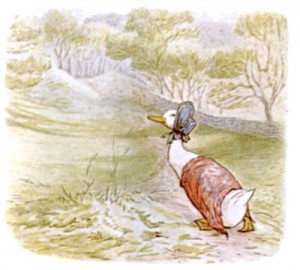 Picture books are written to be read by an adult to a child. The vocabulary is often quite sophisticated—think of Beatrix Potter: “Jemima Puddle-duck became quite desperate. She determined to make a nest right away from the farm.” Many contemporary picture books are tending toward simple, spare text (many of them quite wonderfully, like I Want My Hat Back or the charming Me Hungry); but in my mind the form is dominated by longish stories with rich vocabulary.
Picture books are written to be read by an adult to a child. The vocabulary is often quite sophisticated—think of Beatrix Potter: “Jemima Puddle-duck became quite desperate. She determined to make a nest right away from the farm.” Many contemporary picture books are tending toward simple, spare text (many of them quite wonderfully, like I Want My Hat Back or the charming Me Hungry); but in my mind the form is dominated by longish stories with rich vocabulary.
(To run off on a tangent: I’ve known parents who steered their children away from picture books once the kids learned to read, or hit first grade. Too young, not challenging enough, etc. Au contraire, I say! Picture book text is often MUCH more challenging for an emergent reader than the Early Reader books, about which more in a second. Besides, no one, not anyone, is ever too old for a good picture book. I mean it. All the Places to Love or I Remember Papa can be every bit as moving and cathartic a read for an adult as Persuasion. The Quiltmaker’s Gift is better therapy than Pinterest. I get the same uplifted, happy rush from Mordant’s Wish as I do from About a Boy.)
I’ve had toddlers who liked to cuddle up and listen to long picture books (especially Jane, who spent nearly a year of her toddlerhood in a hospital bed—sitting and listening was one of a very limited range of options, in her case) and toddlers for whom the concept of sitting in one place for a 32-page stretch was a notion for another universe. (Hello, darling Bean.) 😉 For those children especially, but really for all my two- and three-year-olds, I drew (draw, since Huck is this age exactly) heavily on treasured Early Reader favorites like Little Bear, Frog and Toad, The Best Nest, Newt, Biscuit, Mouse Soup, Owl at Home—oh, anything by Arnold Lobel really. And yes, yes, yes, absolutely Elephant and Piggy. We’ve had stretches these past few years where I bet I read five or six Elephant and Piggy books a day—five or six times each! Both Wonderboy and Rilla made giant leaps toward reading thanks to Mo Willems and his animal antics.
 I also had the fun of trying out both my Inch and Roly series and Fox and Crow Are Not Friends on my ready-made test audience here at home. I read my littles the manuscripts straight off the computer. It’s always helpful to read your work aloud, but when you’re writing an early reader or picture book, it’s imperative: if I’m going to inflict a book upon a parent who may, if I’m lucky, be called upon to read the book over and over and over, I’ve got to do my best to make sure that isn’t a torturous experience. And not just that. Reading a manuscript aloud always alerts you to clunky bits that need more polish. And children, even (especially?) your own children, will inform you with unabashed clarity where you’ve lost their attention. My early reader manuscripts are much tighter after a round or two (or ten) of read-alouds to Huck and Rilla. When they start asking for ‘that story’ again—‘you know, Mommy, that book on your computer’—then I know I’m on the right track.
I also had the fun of trying out both my Inch and Roly series and Fox and Crow Are Not Friends on my ready-made test audience here at home. I read my littles the manuscripts straight off the computer. It’s always helpful to read your work aloud, but when you’re writing an early reader or picture book, it’s imperative: if I’m going to inflict a book upon a parent who may, if I’m lucky, be called upon to read the book over and over and over, I’ve got to do my best to make sure that isn’t a torturous experience. And not just that. Reading a manuscript aloud always alerts you to clunky bits that need more polish. And children, even (especially?) your own children, will inform you with unabashed clarity where you’ve lost their attention. My early reader manuscripts are much tighter after a round or two (or ten) of read-alouds to Huck and Rilla. When they start asking for ‘that story’ again—‘you know, Mommy, that book on your computer’—then I know I’m on the right track.
Anyway, to return to the question:
By all means, add Early Readers to the toddler’s read-aloud shelf.
As for the first question, about longer-form read-alouds for three-year-olds, we usually do Pooh around age four (though Rilla didn’t cotton to it at that age; nor did Wonderboy), and we nearly always read the My Father’s Dragon series as our first novels. I have a list of other good read-alouds for four-year-olds here. I remember reading The Lion, the Witch, and the Wardrobe to Jane at age four, and Rose’s obsession at that age (and long afterward) was anything to do with Greek myths, but Rilla (at age six) still MUCH prefers picture books and Early Readers over anything that looks like a novel. She eyed Brambly Hedge with suspicion at first, because of its size (we have the large Treasury edition that includes all the books), but its profusion of pictures won her over. She also loved The Cottage by Bantry Bay and The Family Under the Bridge. But now it’s back to ‘Too long, not enough pictures, I only like picture books.’ Which is fine with me. Our picture-book collection occupies a formidable amount of square footage in this little house; it’s got to earn its keep. 🙂
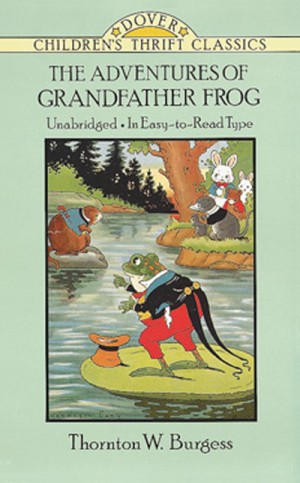 Besides the list of short novels and story collections I linked to above, let me throw in a vote for Thornton Burgess’s various animal stories (available in inexpensive Dover editions). Also the Family Treasury of Little Golden Books: obviously, those are picture books, not novels, but the older Golden Books tend to be quite text-rich. Any good collection of folk or fairy tales is an excellent choice for three- and four-year-olds (though don’t be surprised if most fairy tales turn out to be too long for a three-year-old to hear in one sitting; that goes for any longer-form prose story, really). Just So Stories—delicious—already on my other list, I think.
Besides the list of short novels and story collections I linked to above, let me throw in a vote for Thornton Burgess’s various animal stories (available in inexpensive Dover editions). Also the Family Treasury of Little Golden Books: obviously, those are picture books, not novels, but the older Golden Books tend to be quite text-rich. Any good collection of folk or fairy tales is an excellent choice for three- and four-year-olds (though don’t be surprised if most fairy tales turn out to be too long for a three-year-old to hear in one sitting; that goes for any longer-form prose story, really). Just So Stories—delicious—already on my other list, I think.
As I list all these suggestions, I’m aware that Huck (who will be four in January) is not ready for many of them. Too much text for his busy, bouncy body. I could woo him with Just So Stories, I think (note to self: give it a try) and the Little Golden Books, but he wandered off quickly when I was reading a Burgess story to Rilla the other day. What he wants, over and over and over and whyyyy did we succumb to the request?, is a Thomas the Tank Engine 8×8 we picked up after my booksigning last week. I am Beezus, he is Ramona, and this book is our Scoopy.
(I guarantee you no one involved in the publication of this Thomas book read it out loud even once, much less six times a day, every day for a week. I’m just saying.)

Speaking of picture books and early readers! (And every other kind of children’s book.) There’s still a week left to nominate your favorite books of the past year for the CYBILs Awards. Book apps, too! That’s the committee I’m serving on this year. I’d love to hear what your 2012 picks are.
Oh, and it’s Monday, which means a new Thicklebit.

Kirkus reviews Fox and Crow Are Not Friends:
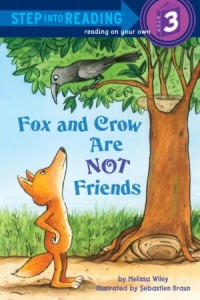
The familiar fable about Fox and Crow, retold for new readers.
Youngsters will quickly understand the word “outfoxed” after reading these tales of flattery, greed and cheese, told as three connected short stories. Fox and Crow are enemies, fighting over one hunk of cheese as if it were the last morsel of food on the planet. It won’t take long for readers to giggle at just how far these two will go for the cheese. Fox gets the best of Crow in the first story, in which Fox flatters Crow into dropping the cheese directly into Fox’s mouth. Next, Crow dreams of ways to get the cheese back and spends every waking moment constructing a cunning trap, with stew-covered Crow as the lure. Success! Fox retaliates in the final chapter, but both critters are outsmarted by the watchful Mama Bear. Humorous watercolor illustrations are punctuated by thought bubbles showing the animal’s plans; other playful details include the owl’s eyes watching the shenanigans from a safe distance and the eventual sheepish looks when the enemies are trapped in the same net, with Mama Bear chastising them from the side.
Funny chapter titles will amuse adults, and subtle visual details make this a fable book that new readers will return to. (Early reader. 3-7)
Yippee! Oh, you guys, I can’t wait for you to see Sebastien’s art in this book. He did a marvelous job—so much humor and energy in his work. I’m over the moon.

 I love Charlie Gilkey’s book Start Finishing, and I’ve truly taken his advice to heart this past year, but BOY do I have a hard time with the crucial first step in his road map, which is recognizing that most of the time we can’t be actively moving forward on more than five projects at once.
I love Charlie Gilkey’s book Start Finishing, and I’ve truly taken his advice to heart this past year, but BOY do I have a hard time with the crucial first step in his road map, which is recognizing that most of the time we can’t be actively moving forward on more than five projects at once. 5. Book outreach — the one I’m forever neglecting — my newsletter and blog posts and reaching out to podcasters & teachers. I mean, this is really a whole job by itself! There are, like, professionals who make their entire living out of it! But the vast majority of published authors can’t afford that kind of help. We’ve got to champion our books ourselves. Which is…kind of excruciating? I would rather champion OTHER PEOPLE’S books. (Like Tanita Davis’s new one. You should buy it!)
5. Book outreach — the one I’m forever neglecting — my newsletter and blog posts and reaching out to podcasters & teachers. I mean, this is really a whole job by itself! There are, like, professionals who make their entire living out of it! But the vast majority of published authors can’t afford that kind of help. We’ve got to champion our books ourselves. Which is…kind of excruciating? I would rather champion OTHER PEOPLE’S books. (Like Tanita Davis’s new one. You should buy it!)
Independent bookstores are begging customers to order holiday gifts early—like, NOW, no time to lose!—to ensure deliveries by December. Which means we authors need to make that plea, too. If you’d like to give one of my books (or Scott’s! They’re awesome) to the kids and teachers on your gift list, now is a perfect time. Same goes for any other books. Especially backlist titles that may already be in stock on the shelves at your favorite indie bookstore. Snap those up and everybody wins!







